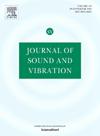预测概念翼型结构在极端飞行环境下的倾翻现象
IF 4.9
2区 工程技术
Q1 ACOUSTICS
引用次数: 0
摘要
本文研究了一个概念翼型系统在周期性激励和极端随机载荷作用下的倾转现象,该系统采用非高斯lsamvy噪声建模。首先,揭示了lsamvy噪声的主要参数对翻倒现象的影响。研究发现,增大的噪声强度或降低的稳定性指数都可能导致在相应确定性系统的分岔点之前发生倾翻现象。此外,与理想的高斯白噪声相比,lvmys噪声的大幅上升和跳跃更容易导致灾难性的高振幅振荡。然后,给出了翼型系统保持在高振幅振荡状态的停留概率,进一步量化了由lsamvy噪声引起的倾翻现象的可能性。为了实现对这些灾难性的高振幅振荡的预测,基于驻留概率定义了高风险区域的概念。最后,对可能发生lsamy噪声引起的倾翻现象的相关参数范围进行了近似量化。这些研究结果可以为工程师预防翼型结构的灾难性倾翻现象提供理论指导,从而提高飞机在极端环境下的运行安全性。本文章由计算机程序翻译,如有差异,请以英文原文为准。
Predicting tipping phenomenon in a conceptual airfoil structure under extreme flight environment
This paper investigates the tipping phenomenon in a conceptual airfoil system subjected to both periodic excitation and extreme random loads modeled by non-Gaussian Lévy noise. Firstly, the effects of main parameters of Lévy noise on the tipping phenomenon are uncovered. It is found that an increased noise intensity or a reduced stability index can induce the tipping phenomenon to take place before the bifurcation point of the corresponding deterministic system. Moreover, large rises and jumps in Lévy noise can more easily lead to catastrophic high-amplitude oscillations than the ideal Gaussian white noise. Then, the residence probability of the airfoil system remaining in high-amplitude oscillations is given to further quantify the likelihood of the tipping phenomenon induced by Lévy noise. To realize the prediction of these catastrophic high-amplitude oscillations, a concept of the high-risk region is defined based on the residence probability. Finally, the ranges of the related parameters, where Lévy noise-induced tipping phenomenon may occur, are approximately quantified. These findings may provide theoretical guidance for engineers in preventing catastrophic tipping phenomena in airfoil structures, thereby enhancing the safety of aircraft operations in extreme environments.
求助全文
通过发布文献求助,成功后即可免费获取论文全文。
去求助
来源期刊

Journal of Sound and Vibration
工程技术-工程:机械
CiteScore
9.10
自引率
10.60%
发文量
551
审稿时长
69 days
期刊介绍:
The Journal of Sound and Vibration (JSV) is an independent journal devoted to the prompt publication of original papers, both theoretical and experimental, that provide new information on any aspect of sound or vibration. There is an emphasis on fundamental work that has potential for practical application.
JSV was founded and operates on the premise that the subject of sound and vibration requires a journal that publishes papers of a high technical standard across the various subdisciplines, thus facilitating awareness of techniques and discoveries in one area that may be applicable in others.
 求助内容:
求助内容: 应助结果提醒方式:
应助结果提醒方式:


